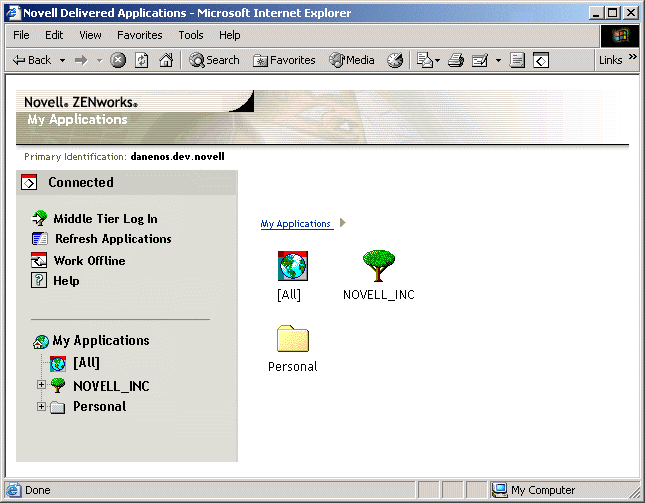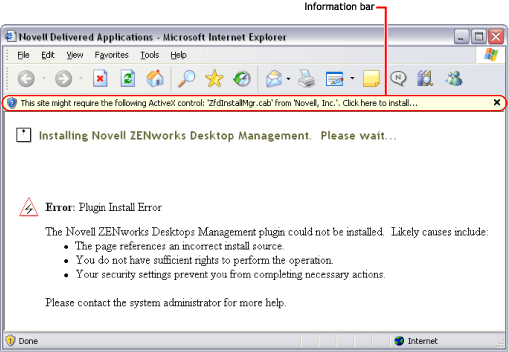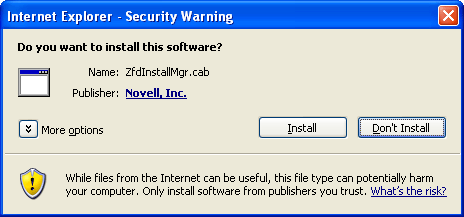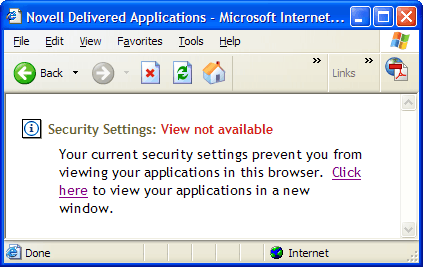19.3 Application Browser
Application Browser, shown below, is a Web browser view similar to the Application Window and the Application Explorer window.
The following sections contain additional information:
19.3.1 Application Browser Description
Figure 19-3 Application Browser View

The Application Browser functionality is limited compared to the Application Window and Application Explorer. The view displays the following:
-
[All] folder: Contains all applications that have been distributed to the user. This is an administrator-controlled feature. By default, it is enabled, which means the folder appears. You can disable the feature if desired. For instructions, see Configuring User Settings.
-
eDirectory trees: Each tree contains the applications, located within the tree, that have been distributed to the user or workstation. Application Launcher displays only the trees to which the user is authenticated.
-
Personal folder: Provides a location for the user to create personal folders for organizing applications. This is an administrator-controlled feature. By default, it is disabled, which means the folder does not appear. For information about enabling personal folders, see Configuring User Settings.
In the Application Browser, the Personal folder structure is for viewing and launching only. If users want to create or delete subfolders, add applications, or remove applications, they must use the Application Window or Application Explorer.
19.3.2 What Users Can Do with the Application Browser
Using the Application Browser, users can do the following:
-
Run an application by double-clicking the application's icon in the right pane. Depending on the application and how it is configured in eDirectory, the Application Launcher might install files to the workstation, map drives, or change workstation configuration files or settings.
-
View the properties of an application. The properties include a description of the application, information about people to contact for help with the application, the times when the application is available for use, and the workstation requirements established for the application.
-
Verify (fix) problems with an installed application. Verifying an application causes Application Launcher to redistribute the application to the workstation.
-
Uninstall an application. This is an administrator-controlled feature. By default, it is disabled. You can enable it on a per-application basis. For information, see Section 43.1, Enabling an Application to be Uninstalled.
19.3.3 Why Use the Application Browser?
The primary purpose of the Application Browser is to provide applications in a Web browser environment. You can enable users to launch the Application Browser independently, or you can integrate it into a Web portal, such as Novell Portal Services or Novell exteNd Director™, so that your applications are presented alongside Web content you've made available to users.
19.3.4 Running the Application Browser Under Windows XP SP2 or Later
Because of security changes in Windows XP Service Pack 2 (SP2), the Application Browser behaves differently on Windows XP SP2 or later workstations. As an administrator, you should communicate these changes to affected users.
The following sections contain additional information:
Internet Explorer Information Bar and Add-On Installs
When a Web page refers to an ActiveX control that is not currently on the workstation, users are asked whether or not they want the ActiveX control to be downloaded. In Windows XP SP2, this prompt is displayed in the information bar. The information bar displays in between the Internet Explorer toolbars and the Web page when a notification is present, and disappears on the next navigation.
NOTE:Displaying the information bar is enabled by default; however, the user can change the default setting so that the information bar does not display. Additionally, the ActiveX controls are installed automatically, without the information bar being displayed, if the publisher of the control (such as Novell) has been previously marked by the user as trusted.
When a user running Windows XP SP2 or later accesses the Application Browser for the first time (assuming that the user is using the default settings and has not marked Novell as trusted), the following error message displays in the Web page and the information bar displays directly above it.
Figure 19-4 Information Bar Displayed In Internet Explorer

Clicking the information bar, then clicking Install ActiveX Control displays the following dialog box, from which the user installs the ActiveX control.
Figure 19-5 Internet Explorer - Security Warning Dialog Box

Internet Explorer Local Machine Zone Lockdown and Active Content Blocking
When Internet Explorer attempts to open a Web page, it places restrictions on what the page can do, based on the page's Internet Explorer security zone (in Internet Explorer, Tools > Internet Options). In Windows XP SP2 or later, the Local Machine Lockdown is more restrictive than in earlier versions of Windows XP.
Because the ZENworks Application Browser is a locally installed HTML control containing ActiveX controls, the Local Machine Lockdown feature, when combined with the new active content blocking feature, causes the Application Browser to behave differently on Windows XP SP2 or later workstations.
When a user types the URL to the Application Browser in the Address box or clicks a link to the Application Browser in the Favorites list, Internet Explorer shows an unformatted HTML page with the information bar showing the text “To help protect your security, Internet Explorer has restricted this file from showing active content that could access your computer. Click here for options.”
To avoid this situation and make it easier for users to access ZENworks Application Browser, the Application Browser view automatically detects if the Local Machine Lockdown feature is enabled on the workstation. If so, the following intermediate page displays:
Figure 19-6 Internet Explorer Security Warning Page

The user can then execute the link in this page, causing the Application Browser view to display in a new window, from which the user can access applications.
If the user accesses the Application Browser by clicking the icon on the Standard Buttons toolbar in Internet Explorer, the intermediate page does not display and the Application Browser view displays without problems.